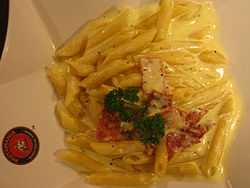Al dente
In cooking, al dente (/ælˈdɛnteɪ/, Italian pron. /alˈdɛnte/) describes pasta and (less commonly) vegetables, rice or beans that are cooked to be firm to the bite.[1][2][3] The etymology is Italian "to the tooth." [4]
In contemporary Italian cooking, the term identifies the ideal consistency for pasta and involves a brief cooking time.[5][6][6] Molto al dente is the culinary term for slightly undercooked pasta.[1][7] Undercooking pasta is used in the first round of cooking when a pasta dish is going to be cooked twice. The culinary term "al forno" is used for pasta dishes that are cooked twice.
Pasta that is cooked al dente has a lower glycemic index than pasta that is cooked soft.[8] When cooking commercial pasta, the al dente phase occurs right after the white of the pasta center disappears.[3]
Misconceptions
The term is occasionally used in reference to cooking vegetables, such as green beans or brussels sprouts, though this is often misunderstood as meaning that instead of being cooked all the way through, they still have a raw taste to them, generally undesirable in cooking. It should be interpreted as cooking them just until they lose their raw taste, as a way to avoid overcooking them.[9][10][11]
A more esoteric usage is also germane to the cooking of meats; specifically, the idea of cooking meats to a specific "under-done" consistency so that further cooking/preparation processes can be applied to the meat, with respect to the additional ingredients. For example, a particularly popular recipe is that of making "sugared bacon", where brown or confectioners sugar is applied to the bacon. Some recipes call for the sugar to be added to raw bacon and then baked. However, other recipes insist that the bacon be cooked "al dente" in a frying pan, set off to the side, sprinkled with confectioners sugar, and then broiled for about 5 minutes. The "al dente" bacon approach is often preferred in that, while the bacon will firm up, the sugar does not crystallize or harden.
See also
References
- ↑ 1.0 1.1 "Essentials of Classic Italian Cooking - Marcella Hazan - Google Books". Books.google.com. 2011-07-20. Retrieved 2014-08-18.
- ↑ "al dente: definition of al dente in Oxford dictionary (American English) (US)". Oxforddictionaries.com. 2014-08-11. Retrieved 2014-08-18.
- ↑ 3.0 3.1 "Dictionary of Food: International Food and Cooking Terms from A to Z - Charles Sinclair - Google Books". Books.google.com. Retrieved 2014-08-18.
- ↑ "Online Etymology Dictionary". Etymonline.com. Retrieved 2014-08-18.
- ↑ "Encyclopedia of Contemporary Italian Culture - Google Books". Books.google.com. Retrieved 2014-08-18.
- ↑ 6.0 6.1 "Italian Cuisine: A Cultural History - Alberto Capatti, Massimo Montanari - Google Books". Books.google.com. 2013-08-13. Retrieved 2014-08-18.
- ↑ "Penne a la vodka Recipe Text | Rouxbe Cooking School". Rouxbe.com. Retrieved 2014-08-18.
- ↑ VA. "Glycemic Index and Diabetes: American Diabetes Association®". Diabetes.org. Retrieved 2014-08-18.
- ↑ "Can Bacon Save Green Beans? Yes, but it Isn't Pretty". Restaurant Widow. 2006-08-08. Retrieved 2014-08-18.
- ↑ "Access". Retrieved 12 September 2014.
- ↑ cdkitchen®. "Brussels Sprout Saute Recipe from". CDKitchen.com. Retrieved 2014-08-18.
External links
| Wikibooks Cookbook has a recipe/module on |
| Look up al dente in Wiktionary, the free dictionary. |
